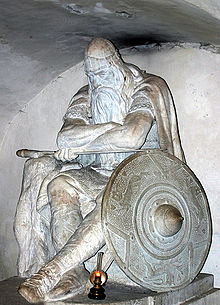- Ogier the Dane
-
"Ogier" redirects here. For other uses, see Ogier (disambiguation)."Holger Danske" redirects here. For other uses, see Holger Danske (disambiguation).
Ogier the Dane (French: Ogier le Danois or archaically Ogier de Danemarche, Danish: Holger Danske) is a legendary character who first appears in an Old French chanson de geste, in the cycle of poems Geste de Doon de Mayence.
Contents
Possible historic basis
The 12th c. Danish chronicler Saxo Grammaticus was not familiar with the character and Ogier has not been connected to any historic event in Denmark.[1] However, there is a chronicle from St Martin's monastery in Cologne which claims that the monastery had been pillaged by the Saxons in 778, but that it was rebuilt by an "Olgerus, dux Daniæ", with the help of Charlemagne.[1]
Chansons de geste
Ogier makes his first appearance in Chanson de Roland from the 11th century, and later in a number of rhyme chronicles from the 12th to 14th centuries, where his life is elaborated on considerably with several adventures.[1]
According to his legend, he is the son of Geoffrey, king of Denmark. In La Chevalerie Ogier de Danemarche, he had a son who was slain by Charlot, son of Charlemagne. Seeking revenge, Ogier sought out and slew Charlot, and was only barely prevented from killing Charlemagne. He resisted Charlemagne for seven years but made peace with him to fight at Charlemagne's side against the Saracens, in which battle he slew the giant Brehus.
Ogier the Dane had a sword named Curtana which, according to legend, bore the inscription "My name is Cortana, of the same steel and temper as Joyeuse and Durendal."
 Ogier the Dane (left) on a church mural from the 16th century in Skævinge, Denmark.
Ogier the Dane (left) on a church mural from the 16th century in Skævinge, Denmark.
It is likely that he became known in Scandinavia in the 15th century through the translation of Karlamagnús saga, but he rapidly became popular and he is depicted on 15th-century paintings in two churches in Denmark and Sweden.[1]
In 1515, Kristiern Pedersen was living in Paris, and there he translated a prose novel based on the rhyming chronicles into the Danish Olger Danskes krönike, which was printed in 1534.[1] Pedersen made Ogier into the son of a Danish king named "Godfred" who leaves Ogier as hostage to Charlemagne.[1] This translation quickly became popular in Denmark.[1]
Like Frederick Barbarossa, Saint Wenceslas and King Arthur, in Danish legend Ogier becomes a king in the mountain; he is said to dwell in the castle of Kronborg, his beard grown down to the floor He will sleep there until some day when the country of denmark is in peril, at which time he will rise up and save the nation. The largest WWII Danish resistance group, Holger Danske, was named after the legend.
In some versions, Morgue le Faye (commonly known today as Morgan le Fay) takes him to Avalon, from where he returns after two hundred years to save France. According to the tour guides of Kronborg Castle, legend has it that Holger sat down in his present location after walking all the way from his complete battles in France.
The 1789 opera Holger Danske, composed by F.L.Æ. Kunzen with a libretto by Jens Baggesen, had a considerable impact on Danish nationalism in the late 18th century. It spawned the literary "Holger feud," which revealed the increasing dissatisfaction among the native Danish population with the German influence on Danish society. Amongst others, the Danish intellectual Peter Andreas Heiberg joined the feud by writing a satirical version entitled Holger Tyske ("Holger the German") ridiculing Baggesen's lyrics.
Modern works
Poul Anderson's fantasy novel Three Hearts and Three Lions (ISBN 0-671-72186-0) (1961) draws upon these legends and also alters them. Its protagonist Holger Carlsen (a Danish resistance fighter) is transported to a fantasy alternate history where the Matter of France is historical. He eventually learns that he is Ogier the Dane, sent to our universe to remove him from the conflict between humans and Faerie in that one. At the book's end he returns to our world in time to cover Niels Bohr's escape to Sweden and prevent the Gestapo from capturing him - thus facilitating Bohr's part in the Manhattan Project and effectively fulfilling the prophecy that Ogier would return at the time of France and Denmark's grave need.
In his recent (2010, Harvill Secker) novel I Curse the River of Time (translated into English by Charlotte Barslund, with the author), award-winning Norwegian novelist Per Petterson endows a small ferry sailing between Norway and Denmark with the name Holger Danske; one of the main characters - a dying Danish woman going home - feels accepted and understood by its crew. She has lost a son some years ago. The ferry's name may or may not be relevant to the story, which has many interwoven strands.
References
- ^ a b c d e f g The article Holger Danske in Nordisk familjebok (1909)
Categories:- Fictional knights
- Danish legendary figures
- Chansons de geste
- Matter of France
- Characters in The Song of Roland
Wikimedia Foundation. 2010.

